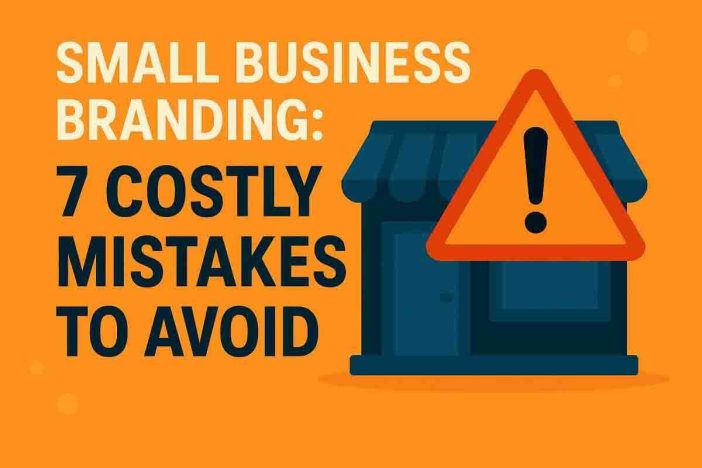
On a rainy Thursday morning in Boston, Maria stood in her small bakery, watching the empty tables with a sinking feeling. Her croissants were buttery perfection, her coffee beans imported from the finest farms in Colombia—yet customers kept drifting to the new café across the street. It wasn’t the taste that drew them away. It was the atmosphere, the vibe, the way that café’s colors, logo, and social media presence made people feel connected to something bigger than breakfast. That was when Maria realized the hard truth: small business branding isn’t just about having a product. It’s about crafting an experience people remember.
This is where many entrepreneurs stumble. They think branding begins and ends with a logo or catchy slogan. In reality, branding is your silent salesperson, your reputation, the emotional connection between you and your customers. Done right, it can transform a modest store into a beloved local landmark—or a viral sensation online. Done wrong, it can leave your business struggling in the shadows.
Today, we’ll uncover the seven costly mistakes businesses make with small business branding, complete with real data, examples, and actionable steps to help you avoid them.
Costly Mistakes to Avoid With Small Business Branding
1. Ignoring Brand Identity
Your brand identity is the sum of everything customers see, hear, and feel about your business. Colors, typography, tone of voice, packaging design—all of these whisper (or shout) what you stand for. Ignore this, and your business blends into the noise.
According to a Lucidpress study, consistent branding can increase revenue by up to 23%. Think about brands like Apple or Starbucks. Even without reading the name, you recognize their ads, products, or stores instantly. That’s not an accident—it’s strategic.
For small businesses, creating a clear brand identity doesn’t require millions. Start with three simple steps:
- Choose two or three colors and stick to them across your website, packaging, and social media.
- Develop a brand voice: Are you playful and fun, or professional and authoritative?
- Use the same logo design everywhere—on bags, receipts, Instagram posts, and email newsletters.
Consistency builds familiarity. Familiarity builds trust. And trust is what keeps customers coming back.
2. Inconsistent Messaging
Ever visited a website that sounded warm and welcoming, only to see its social media captions written in stiff, corporate language? That’s inconsistent messaging, and it confuses customers.
Your messaging is more than words; it’s the personality of your brand. Research from Sprout Social shows that 64% of consumers want brands to connect with them. That connection happens when your voice feels authentic and consistent across every platform.
Here’s how to fix it:
- Create a short “Brand Voice Guide” that outlines your tone.
- Use the same key phrases in ads, blogs, and social media captions.
- Train your team so even customer service emails sound like they came from the same brand personality.
Consistency in messaging makes your business feel human, approachable, and trustworthy.
3. Skipping Digital Presence
It’s 2025, and yet many small businesses still treat websites or social media as optional. Big mistake. A survey by BrightLocal revealed that 98% of consumers use the internet to find local businesses before making a purchase.
That means if your business isn’t showing up online—or looks outdated when it does—you’re losing customers before they even walk through the door.
To build a strong digital presence:
- Invest in a simple, mobile-friendly website. Platforms like WordPress or Wix make this affordable.
- Claim your Google Business Profile. This helps you appear on maps, reviews, and “near me” searches.
- Post regularly on one or two social media platforms where your audience hangs out.
Remember, your digital presence often makes the first impression—long before someone visits your store.
Building a strong digital presence begins with choosing the right platform for your online store. The article “Best E-Commerce Platforms for Small Business: 7 Powerful Picks” offers insights into platforms that align functionality with brand identity. Understanding the best options ensures your small business branding remains consistent and professional across all digital touchpoints.
4. No Emotional Connection
Branding isn’t just about visuals; it’s about feelings. Neuroscience tells us that emotions drive 80% of consumer decisions. People might forget your product features, but they’ll never forget how you made them feel.
Consider Coca-Cola’s campaigns. They rarely talk about ingredients. Instead, they sell happiness, friendship, and memories. That emotional storytelling is why Coca-Cola remains one of the most recognized brands globally.
For small businesses:
- Share your story: Why did you start? What do you believe in?
- Use customer testimonials and real photos instead of stock images.
- Create experiences: A bookstore hosting poetry nights builds memories, not just sales.
Emotional branding turns transactions into relationships—and relationships into loyalty.
Personal branding adds a human touch to your small business, especially when you as the owner are the face of the brand. The article “Personal Brand Statement: 7 Powerful Ways to Win” reveals practical ways to create a compelling personal brand statement that strengthens emotional connection and customer loyalty.
5. Underestimating Brand Awareness Campaigns
If people don’t know you exist, they can’t buy from you. Yet many small businesses rely solely on word-of-mouth. While referrals are powerful, brand awareness campaigns amplify your reach exponentially.
Statistics from HubSpot show that companies publishing blogs get 55% more website visitors than those that don’t. Add social media collaborations or local sponsorships, and your visibility grows even faster.
Practical ideas for boosting brand awareness:
- Partner with a local influencer to review your product.
- Host a community event and share highlights online.
- Run small Facebook or Instagram ad campaigns targeting nearby neighborhoods.
The goal isn’t just to be seen once—it’s to be remembered.
Deciding whether to sell on marketplaces or run your own store directly impacts your brand’s visibility and customer experience. The article “Selling on Marketplaces vs Own Website: 7 Shocking Secrets” explores the pros and cons of each option so you can maintain control over your branding strategy while reaching your target audience effectively.
6. Neglecting Customer Feedback
Ignoring customer feedback is like covering your ears while people tell you how to improve. Reviews, surveys, and casual comments hold valuable insights about what’s working—and what isn’t.
Data from Qualtrics shows that 77% of consumers view brands more favorably if they ask for and accept feedback.
Here’s how to use feedback effectively:
- Ask for reviews after each purchase—online or in person.
- Use negative reviews constructively. Respond politely and fix the issue.
- Highlight positive feedback on your website or social channels.
Feedback isn’t criticism; it’s free market research helping you grow stronger.
7. Failing to Adapt and Innovate
Branding isn’t a one-time project. Trends, technology, and customer expectations evolve—your brand should too.
Take sustainability, for example. A Nielsen report found that 73% of global consumers would change consumption habits to reduce environmental impact. Brands embracing eco-friendly packaging or social responsibility campaigns attract modern, conscious buyers.
For small businesses:
- Stay updated with industry trends through blogs or webinars.
- Refresh your visuals or slogans every few years to stay modern.
- Experiment with new platforms like TikTok or emerging ad tools if your audience shifts there.
Adapting doesn’t mean losing your identity. It means staying relevant while staying true to your values.
Actionable Branding Checklist
Here’s a quick checklist to transform your small business branding starting today:
- Audit your brand visuals: Are they consistent across all platforms?
- Write down your brand story in one paragraph.
- Post at least twice a week on social media with a clear voice.
- Encourage and respond to customer reviews.
- Collaborate with a local event or influencer for visibility.
- Review your brand strategy every six months for updates.
Small steps, taken consistently, lead to big branding wins.
Wrap It Up
Branding isn’t about spending millions or hiring celebrity spokespeople. It’s about clarity, consistency, and connection. By avoiding these seven costly mistakes—ignoring brand identity, inconsistent messaging, skipping digital presence, lack of emotional connection, weak brand awareness campaigns, neglecting feedback, and refusing to adapt—you set your small business on the path to recognition and loyalty.
Remember Maria, the bakery owner? After rebranding with a fresh logo, sharing her story online, and hosting weekly “Meet the Baker” events, her café became a neighborhood favorite within months.
Your business can too. Because at its heart, small business branding isn’t about products. It’s about people—and the stories they’ll tell about you tomorrow.



